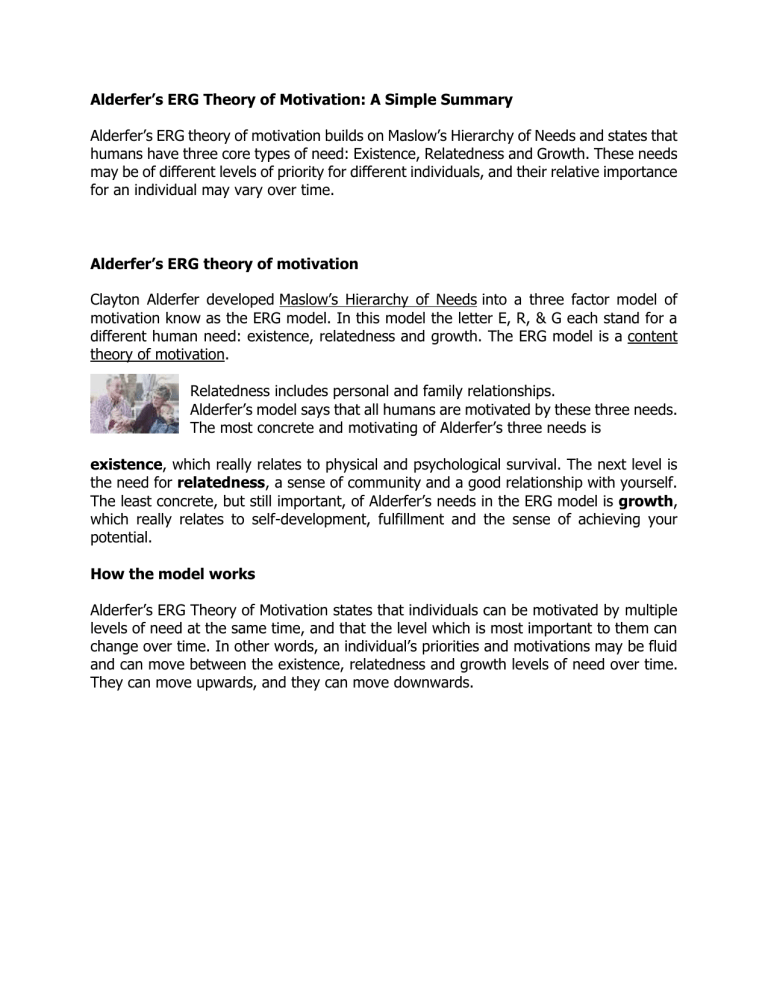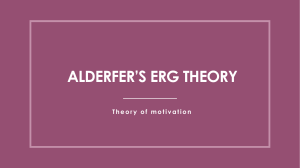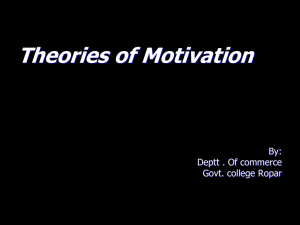
Alderfer’s ERG Theory of Motivation: A Simple Summary Alderfer’s ERG theory of motivation builds on Maslow’s Hierarchy of Needs and states that humans have three core types of need: Existence, Relatedness and Growth. These needs may be of different levels of priority for different individuals, and their relative importance for an individual may vary over time. Alderfer’s ERG theory of motivation Clayton Alderfer developed Maslow’s Hierarchy of Needs into a three factor model of motivation know as the ERG model. In this model the letter E, R, & G each stand for a different human need: existence, relatedness and growth. The ERG model is a content theory of motivation. Relatedness includes personal and family relationships. Alderfer’s model says that all humans are motivated by these three needs. The most concrete and motivating of Alderfer’s three needs is existence, which really relates to physical and psychological survival. The next level is the need for relatedness, a sense of community and a good relationship with yourself. The least concrete, but still important, of Alderfer’s needs in the ERG model is growth, which really relates to self-development, fulfillment and the sense of achieving your potential. How the model works Alderfer’s ERG Theory of Motivation states that individuals can be motivated by multiple levels of need at the same time, and that the level which is most important to them can change over time. In other words, an individual’s priorities and motivations may be fluid and can move between the existence, relatedness and growth levels of need over time. They can move upwards, and they can move downwards. Comparing Alderfer and Maslow In Maslow’s Hierarchy of Needs, individuals need to have satisfied one level of needs before moving on to the next one. For example, they need to have satisfied their safety needs before being motivated by social belonging. Alderfer disagreed. In his model, individuals do not need to have satisfied their existence needs before being motivated by their relatedness need. In fact, Alderfer went further and said that different individuals potentially prioritize the needs in different orders based on their life views. A standard example of this could be the starving actor who’s motivated by growth through their art, potentially at the expense of their existence (i.e. they can’t pay their rent but are pursuing their passion). Alderfer also noted that how individuals perceive their progression in relation to each of the levels of need is important. If an individual feels they are making great progress at relatedness, they may be increasingly motivated by growth even though their relatedness need has not been fully satisfied. Similarly, if an individual feels frustrated with the progress they are making in relation to growth, they may abandon it and redouble their motivation in relation to relatedness. The ERG model in the world of work Perhaps our needs are more balanced than Maslow thought. In Maslow’s model, individuals remain at a fixed level of need until they have satisfied it. This would mean that individuals at work should work towards satisfying their current stage of need, and that leaders and managers should focus on helping the members of their teams achieve one specific level of needs at a time. Alderfer’s ERG Theory of Motivation, though, upends this thinking. Under Alderfer’s model individuals can be motivated by different levels at the same time, and have their motivational priorities change in relation to their sense of progress. Given this, individuals should not focus on one level of need at a time. Instead, they may wish to balance their motivations across levels. Similarly, leaders should not focus on helping the members of their team satisfy one level of need at a time. Instead, they should be aware of the blend of needs that humans can have and help their team members progress in relation to a blend of needs, which will change over time. Learning More We’ve written several articles on various content and process theories of motivation that you might find interesting. These include articles on Adam’s equity theory and Herzberg’s two factor theory of motivation. We’ve also written an introductory post of Adair’s 8 basic rule of motivation and have a guest post on Reversal Theory. You can listen to our podcast on reversal theory below: The World of Work Project View The ways that Alderfer’s ERG Theory of Motivation has built on Maslow’s model are helpful, particularly the fact that the order of the needs can differ. One of the core criticisms of Maslow’s model was that while there might be some agreement on the existence of core human needs, that their order and priority isn’t empirically agreed at all. This model addresses that challenge to some extent. However, despite this, the model itself isn’t as easy to relate to as Maslow’s. Nor does it provide as directional advice, which is something that people often look for. So while the model is perhaps a bit more robust than Maslow’s, in our view it’s unlikely to be either all that popular or all that useful in the world of work.


